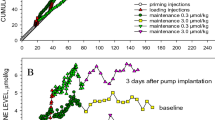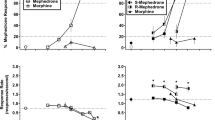Abstract
The onset and persistence of changes in 3H-spiroperidol binding to dopamine (DA) D2 receptors were examined in rat mesolimbic and striatal regions following daily administration of haloperidol, molindone, or sulpiride for 3, 7, 14, or 28 days. Neuroleptic dose equivalencies were determined by inhibition of 3H-spiroperidol in vivo binding in several rat brain regions. Changes in locomotor and stereotyped responses to the specific DA D2 agonist quinpirole were examined 3 days after the last treatment dose. Haloperidol or molindone administration increased mean stereotypy scores and striatal DA D2 receptor densities throughout the 28-day treatment period. In contrast, mesolimbic DA D2 receptor densities were transiently increased and returned to control values after 28 days of haloperidol or molindone treatment. Sulpiride treatment increased mean stereotypy scores and striatal Bmax values, but had no effect on locomotion or mesolimbic dopamine receptor density. Additionally, the magnitude of change in the various measures of brain DA function varied among the three neuroleptic treatment groups. Results from this study suggest that mesolimbic and striatal brain regions differ in their response to long-term neuroleptic administration and that drug choice may influence the magnitude of neuroleptic-induced dopaminergic supersensitivity.
Similar content being viewed by others
References
Andersen PH, Nielsen EB, Gronvald FC, Braestrup C (1986) Some atypical neuroleptics inhibit (3H)SCH-23390 binding in vivo. Eur J Pharmacol 120:143–144
Arnt J (1983) Neuroleptic inhibition of 6,7-ADTN-induced hyper-activity after injection into the nucleus accumbens: specificity and comparison with other models. Eur J Pharmacol 90:47–55
Ayd FJ Jr (1974) A critical evaluation of molindone (Moban): a new indole derivative neuroleptic. Dis Nerv Syst 35:447–452
Bannet J, Gillis S, Ebstein RP, Belmaker RH (1980) The effect of chronic sulpiride on striatal spiperone binding. Int Pharmacopsychiatry 15:334–337
Baudry M, Martres MP, Schwartz JC (1977) In vivo binding of 3H-primozide in mouse striatum: effects of dopamine agonists and antagonists. Life Sci:1163–1170
Borenstein P, Champion C, Cujo P, Gekiere F, Olivenstein C, Kramarz P (1969) An original psychotropic drug: sulpiride. Sem Hop Paris 45:1301–1314
Burt DR, Creese I, Snyder SH (1977) Antischizophrenic drugs: chronic treatment elevates dopamine receptor binding in brain. Science 196:326–328
Campbell A, Baldessarini RJ, Teicher MH, Kula NS (1985) Prolonged antidopaminergic actions of single doses of butyrophenones in the rat. Psychopharmacology 87:161–166
Chiodo LA, Bunney BS (1983) Typical and atypical neuroleptics: differential effects of chronic administration on the activity of A9 and A10 midbrain dopaminergic neurons. J Neurosci 3:1607–1619
Chivers J, Jenner P, Marsden CD (1987) Pharmacological characterization of binding sites identified in rat brain following in vivo administration of [3H]-spiperone. Br J Pharmacol 90:467–478
Chuoinard G, Jones BD (1980) Neuroleptic-induced supersensitivity psychosis: clinical and pharmacological characteristics. Am J Psychiatry 137:16–21
Christensen AV, Arnt J, Svendsen O (1985) Pharmacological differentiation of dopamine D-1 and D-2 antagonists after single and repeated administration. Psychopharmacology [Suppl] 2:183–190
Clow A, Theodorou A, Jenner P, Marsden CD (1980) A comparison of striatal and mesolimbic dopamine function in the rat during 6-month trifluoperazine administration. Psychopharmacology 69:227–233
Costall B, Naylor RJ (1977) Mesolimbic and extrapyramidal sites for the mediation of stereotyped behavior patterns and hyperactivity by amphetamine and apomorphine in the rat. Adv Behav Biol 21:47–76
Csernansky JG, Csernansky CA, Hollister LE (1985) 3(H)-Sulpiride labels mesolimbic non-dopaminergic sites that bind antide-pressant drugs. Experientia 41:1419–1421
Ferrero P, Vaccarino F, Guiodotti A, Costa E, Di Chiro G (1983) In vivo modulation of brain dopamine recognition sites: a possible model for emission computed tomography studies. Neuropharmacology 22:791–795
Fleminger S, Rupniak NMJ, Hall MD, Jenner P, Marsden CD (1983) Changes in apomorphine-induced stereotypy as a result of subacute neuroleptic treatment correlates with increased D-2 receptors, but not with increases in D-1 receptors. Biochem Pharmacol 32:2921–2927
Fuxe K, Ogren SO, Hall H, Agnati LF, Andersson K, Kohler C, Schwarcz R (1980) Effects of chronic treatment with 1-sulpiride and haloperidol on central monoaminergic mechanisms. Adv Biochem Psychopharmacol 24:193–206
Gelenberg AJ, Doller JC (1979) Clozapine versus chlorpromazine for the treatment of schizophrenia: preliminary results from a double-blind study. J Clin Psychiatry 40:238–240
Gerlach J, Thorsen K, Fog R (1975) Extrapyramidal reactions and amine metabolites in cerebrospinal fluid during haloperidol and clozapine treatment of schizophrenic patients. Psychopharmacologia 40:341–350
Goldstein A, Aronow L, Kalman SM (1974) Principles of drug action: the basis of pharmacology. Wiley, New York, pp 82–96
Gulat-Marnay C, Lafitte A Schwartz JC, Protais P (1985) Effects of discriminant and non-discriminant dopamine antagonists on in vivo accumulation of 3H-N-propyl-norapomorphine in mouse striatum and tuberculum olfactorium. Naunyn-Schmiedeberg's Arch Pharmacol 329:117–122
Hyttel J, Larsen JJ, Christensen AV, Arnt J (1985) Receptor-binding profiles of neuroleptics. Psychopharmacology [Suppl] 2:9–18
Jenner P, Hall MD, Murugaiah K, Rupniak N, Theodorou A, Marsden CD (1982) Repeated administration of sulpiride for three weeks produces behavioral and biochemical evidence for cerebral dopamine receptor supersensitivity. Biochem Pharmacol 31:325–328
Jenner P, Rupniak NMJ, Marsden CD (1985) Differential alteration of striatal D-1 and D-2 receptors induced by the long-term administration of haloperidol, sulpiride, or clozapine to rats. Psychopharmacology [Suppl] 2:175–181
Kamer RS, Turi AR, Solomon PR, Kaplan LJ (1981) Increased mesolimbic dopamine binding following chronic haloperidol treatment. Psychopharmacology 72:261–263
Kebabian JW, Calne DB (1979) Multiple receptors for dopamine. Nature 277:93–96
Kendler KS, Bracha HS, Davis KL (1982) Dopamine autoreceptor and postsynaptic receptor blocking potency of neuroleptics. Eur J Pharmacol 79:217–223
Klawans HI Jr (1973) The pharmacology of tardive dyskinesia. Am J Psychiatry 130:82–86
Klemm WR (1985) Neuroleptic-induced catalepsy: a D2 blockade phenomenon? Pharmacol Biochem Behav 23:911–915
Kohler C, Haglund L, Ogren SO (1981) Regional blockade by neuroleptic drugs of in vivo 3H-spiroperidol binding in the rat brain. Relation to blockade of apomorphine induced by hyperactivity and stereotypies. J Neural Transm 52:163–173
Kohler C, Hall H, Gawell L (1986) Regional in vivo binding of the substituted benzamide [3H]eticlopride in the rat brain: evidence for selective labelling of dopamine receptors. Eur J Pharmacol 120:217–226
Kuhar MJ, Murrin LC, Malouf AT, Klemm N (1978) Dopamine receptor binding in vivo: the feasibility of autoradiographic studies. Life Sci 22:203–210
LeFur G, Guilloux F, Uzan A (1980) In vivo blockade of dopaminergic receptors from different rat brain regions by classical and atypical neuroleptics. Biochem Pharmacol 29:267–270
Leslie CA, Bennett JP (1987) [3H]Spiperone binds selectively to rat striatal D2 dopamine receptors in vivo: a kinetics and pharmacological analysis. Brain Res 407:253–262
Leysen JE (1980) 3H-Apomorphine receptors in various rat brain regions: a study of specific and nonspecific binding and the influence of chronic neuroleptic treatment. Adv Biochem Psychopharmacol 24:123–132
Ljungberg T, Ungerstedt U (1978) Classification of neuroleptic drugs according to their ability to inhibit apomorphine-induced locomotion and gnawing: evidence for two different mechanisms of action. Psychopharmacology 56:239–247
Lowry OH, Roseborough NJ, Farr AL, Randall RJ (1951) Protein measurement with the Folin phenol reagent. J Biol Chem 193:265–275
Meller E (1982) Chronic molindone treatment: relative inability to elicit dopamine receptor supersensitivity in rats. Psychopharmacology 76:222–227
Muller P, Seeman P (1978) Dopaminergic supersensitivity after neuroleptics: Time course and specificity. Psychopharmacology 60:1–11
Niemegeers CJE, Janssen PAJ (1979) A systematic study of the pharmacological activities of dopamine antagonists. Life Sci 24:2201–2216
O'Connor SE, Brown RA (1982) The pharmacology of sulpiride: a dopamine receptor antagonist. Gen Pharmacol 13:185–193
Prosser ES, Csernansky JG, Hollister LE (1988) Differences in the time course of haloperidol-induced up-regulation of rat striatal and mesolimbic dopamine receptors. Life Sci 43:715–720
Radhakishun FS, Van Ree JM (1987) The hypomotility elicited by small doses of apomorphine seems exclusively mediated by dopaminergic systems in the nucleus accumbens. Eur J Pharmacol 136:41–47
Rupniak NMJ, Jenner P, Marsden CD (1983) The effect of chronic neuroleptic administration on cerebral dopamine receptor function. Life Sci 32:2289–2311
Rupniak NMJ, Kilpatrick G, Hall MD, Jenner P, Marsden CD (1984) Differential alteractions in striatal dopamine receptor sensitivity induced by repeated administration of clinically equivalent doses of haloperidol, sulpiride or clozapine in rats. Psychopharmacology 84:512–519
Rupniak NMJ, Hall MD, Kelly, E, Fleminger S, Kilpatrick G, Jenner P, Marsden CD (1985) Mesolimbic dopamine function is not altered during continuous chronic treatment of rats with typical or atypical neuroleptic drugs. J Neural Tansm 62:249–266
Schweitzer JW, Schwartz R, Friedhoff AJ (1982) Factors contributing to the up regulation of dopaminergic receptors by chronic haloperidol. Res Commun Chem Pathol Pharmacol 38:21–30
Seeman P (1980) Brain dopamine receptors. Pharmacol Rev 32:229–313
Severson JA, Robinson HE, Simpson GM (1984) Neuroleptic-induced striatal dopamine receptor supersensitivity in mice: relationship to dose and drug. Psychopharmacology 84:115–119
Stoof JC, Kebabian JW (1984) Two dopamine receptors: biochemistry, physiology, and pharmacology. Life Sci 35:2281
Trabucchi M, Memo M, Battaini F, Reggiani A, Spano PF (1980) Effect of long-term treatment with haloperidol and sulpiride on different types of dopaminergic receptors. Adv Biochem Psychopharmacol 24:275–281
Vaccheri A, Dall'Olio R, Gandolfi O, Montanaro N (1986) Involvement of different dopamine receptors in rat diphasic motility response to apomorphine. Psychopharmacology 89:265–268
White F, Wang R (1983) Differential, effects of classical and atypical antipsychotic drugs on A9 and A10 dopamine neurons. Science 211:1054–1056
Author information
Authors and Affiliations
Rights and permissions
About this article
Cite this article
Prosser, E.S., Pruthi, R. & Csernansky, J.G. Differences in the time course of dopaminergic supersensitivity following chronic administration of haloperidol, molindone, or sulpiride. Psychopharmacology 99, 109–116 (1989). https://doi.org/10.1007/BF00634463
Received:
Accepted:
Issue Date:
DOI: https://doi.org/10.1007/BF00634463




